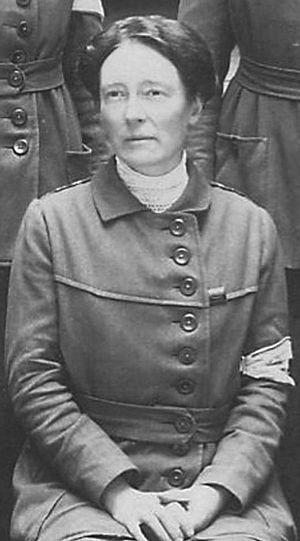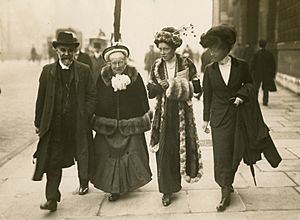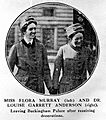Louisa Garrett Anderson facts for kids
Quick facts for kids
Louisa Garrett Anderson
|
|
|---|---|
 |
|
| Born |
Louisa Garrett Anderson
28 July 1873 Aldeburgh, Suffolk, England
|
| Died | 15 November 1943 (aged 70) Brighton, Sussex, England
|
| Education | St Leonards School London School of Medicine for Women |
| Known for | Military hospitals Campaigning for women's rights and social reform |
| Relatives | Flora Murray (partner) Elizabeth Garrett Anderson (mother) Alan Garrett Anderson (brother) |
| Medical career | |
| Profession | Physician and surgeon |
Louisa Garrett Anderson (born July 28, 1873 – died November 15, 1943) was a very important doctor and a champion for women's rights in Britain. She was a leading member of the Women's Social and Political Union (WSPU), a group that fought for women to have the right to vote. She also worked to improve society.
Louisa was the daughter of Elizabeth Garrett Anderson, who was the first woman to become a doctor in Britain. Louisa later wrote a book about her mother's life. Louisa Garrett Anderson became the Chief Surgeon of the Women's Hospital Corps (WHC) and was a respected member of the Royal Society of Medicine. Her aunt, Millicent Fawcett, was also a famous leader who worked for women's voting rights. Louisa's close friend and colleague was another doctor and suffragette named Flora Murray.
Contents
Early Life and Education
Louisa Garrett Anderson was the oldest of three children. Her mother, Elizabeth Garrett Anderson, was not only the first woman doctor in Britain but also helped start the London School of Medicine for Women. She was also the first woman to be elected as a Mayor in Britain. Louisa's father, James George Skelton Anderson, owned a shipping company.
Louisa went to St Leonards School in St Andrews, Scotland. She then studied medicine at the London School of Medicine for Women. She earned her first medical degrees in 1898 and became a Doctor of Medicine in 1900. She continued her studies at Johns Hopkins Medical School in the United States. She also traveled to Paris and Chicago to watch important surgeries.
Starting Her Medical Career
Even with her excellent education, Louisa found it hard to get a job at a big hospital. At that time, many people did not think women doctors should treat both men and women. So, in 1902, she joined the New Hospital for Women. This hospital was started by her mother and only treated women and children.
Louisa first worked as a surgical assistant and later became a senior surgeon. She performed many types of operations, especially those related to women's health. In 1908, she wrote a paper with another doctor about her surgeries and the cases of uterine cancer treated at the hospital.
Fighting for Women's Rights

From 1903, Louisa was involved with groups like the National Union of Women's Suffrage Societies (NUWSS). These groups wanted women to get the right to vote through peaceful ways. However, Louisa became frustrated because progress was very slow.
In 1907, she joined the Women's Social and Political Union (WSPU), a group that used more direct actions. On November 18, 1910, Louisa joined her mother and about 300 other women to ask Prime Minister Herbert Asquith for voting rights. This protest became known as Black Friday. The police and other people treated the protesters very roughly. More than a hundred women, including Louisa, were arrested but later released without any charges.
In 1912, Louisa was briefly held in Holloway Prison for her suffragette actions, which included breaking a window. In 1914, she helped start a new group called the United Suffragists. This group included both women and men who supported women's voting rights. It quickly grew and had branches in several cities.
Medicine During World War I
When World War I started, Louisa Anderson and Flora Murray created the Women's Hospital Corps (WHC). They hired only women to work there. They thought the British War Office might not accept their help, so they offered their services to the French Red Cross instead. The French accepted and gave them a new hotel in Paris to use as a hospital. Flora Murray became the chief physician, and Louisa Anderson became the chief surgeon.
British War Office representatives were surprised to find a hospital successfully run by British women. Soon, their hospital was treated as a British military hospital. The Women's Hospital Corps also ran another military hospital in Wimereux, France.
In January 1915, injured soldiers began to be sent back to England for treatment. The British War Office then asked Murray and Anderson to come back to London. They were asked to run a large hospital called the Endell Street Military Hospital (ESMH) under the Royal Army Medical Corps. This hospital treated almost 50,000 soldiers between May 1915 and September 1919.
At Endell Street, Louisa and the hospital's pathologist, Helen Chambers, developed a new way to treat infected wounds. They used an antiseptic ointment called BIPP (bismuth, iodoform, and paraffin paste). This paste was originally invented by James Rutherford Morison. After Louisa's early tests showed good results, Morison asked her and Chambers to do a bigger study in 1916. Louisa published their findings in The Lancet, a medical journal. She wrote that the BIPP method caused less pain for patients and was better than another method that needed bandages changed very often. With BIPP, bandages could stay on longer, saving a lot of time. BIPP was used by many surgeons for the rest of the war and even in World War II. It is still used today in some medical procedures.
Awards and Recognition
Louisa Garrett Anderson and Flora Murray were both honored for their work in August 1917. They were appointed as Commanders of the Order of the British Empire (CBE). They were among the first people to receive this award.
Later Life and Legacy
Louisa Garrett Anderson passed away in Brighton in 1943. Her ashes were spread over the South Downs. She is remembered on Flora Murray's gravestone near their home. The inscription on the gravestone speaks of their deep friendship and happiness together.
Louisa Garrett Anderson's important papers and records are kept at The Women's Library in London. In 2018, her name and picture were placed on the base of the statue of Millicent Fawcett in Parliament Square, London. This statue honors a great leader of the women's suffrage movement.
Images for kids
See also
 In Spanish: Louisa Garrett Anderson para niños
In Spanish: Louisa Garrett Anderson para niños


